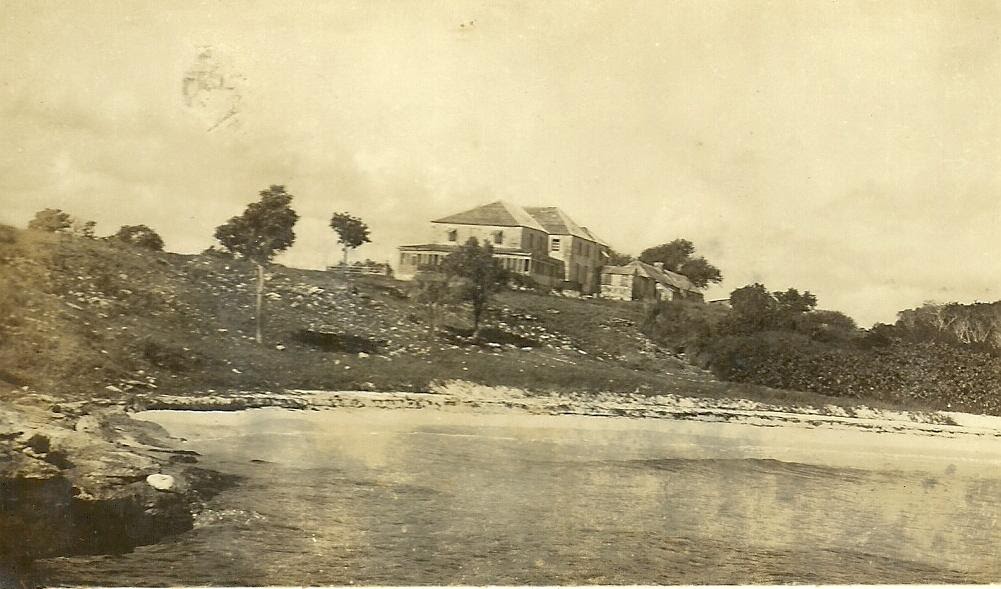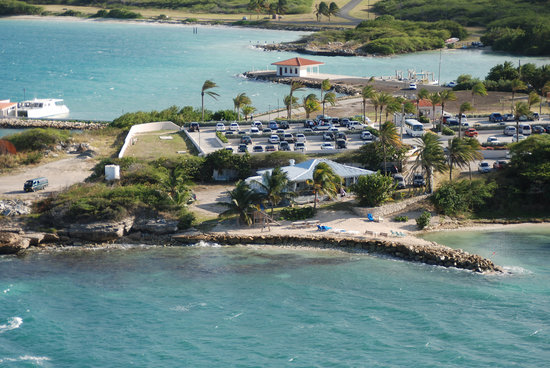About
Type: Ruin
Parish: St.George
Founding date: 1729
See on Google Maps!


Current Status:
There is no longer a mill left standing and the estate house has been rebuilt into apartments. It was built of stone and has withstood the test of time however all wooden appendages such as the galleries have gone by the way. High Point sits above Dutchman’s Bay where Cecelia’s Restaurant, the Lord Nelson Club, and Tides are located.
Estate History/ Timeline
“There was a small building built over the sea to the north of High Point that was called Rock House where as children we could sleep over at night. It was all very exciting.” -Rosemary (Goodwin) Magoris. Many family gatherings and picnics were held at High Point particularly on a Sunday, with use of the nearby beach at Dutchman’s Bay. Mae Conacher’s 21st birthday party was held at High Point with ‘mock champagne’ (ginger ale & white wine) Margaret Conacher. The families referred to are the McSevney’s, Conacher’s, Goodwin’s, and Duncan’s. There were three windows on the second story of the buff house and the middle window was bricked in after a small child crawled out the window, rolling off the roof and resulting in death. This was prior to the McDonald’s time but the window was never reopened and remained sealed forever. John St. Luce purchased the High Point Buff which he turned into four apartments. It is still a residence today (2016).
1795: Dr. John Richardson’s widow, Elizabeth Howell Gumbs, sells her property in St. George’s Parish, in the Division of New North Sound, Antigua for £617 to Samuel Martin, Thomas Jarvis & William Hill. The latter were either tenants or renting High Point estate. (This information was obtained from Dutch Archives in The Hague by Heather Neilson).
Mr. Martin, born 1690, died 1776, had 23 children. One son, Josiah Martin became Governor of the Carolinas, USA, and freed his slaves. Samuel Martin b.1750 in Glen Cree, Scotland. Young Martin’s plantation in Antigua was called “High Point” and lay in the northern part of the island between Winthrop’s Bay and Dutchman’s Bay near the entrance to Parham Harbor. He left his plantation to William, born in 1816, his second son by his second wife. In view of Ms. Shaw’s comments about being a woman hater, it was a little unexpected that Young Martin had two wives and eleven children. He married Grace Savage, daughter of George Savage of “Savage Gardens” just outside St. John’s and by her had six children. She died, aged 50, in 1810, and in 1812 he married again, a widow, name unknown, by whom he had five children more. Mr. Martin died in England, whither he had gone after leaving the collectorship. http://www.artsgla.ac.uk/STELLA/STARN/prose/SHAW/antigua.htm
He died in Box near Bath and it is thought that he committed suicide with a gun to his head supposedly due to depression from bankruptcy.
1801: Charles Curtis was manager for Samuel Martin at High Point from around 1801 to 1812. When Bertie Entwhistle died, Sam Martin was his trustee and because of this connection, Charles Curtis also managed Golden Grove Barnacle Point and Jolly Hill, estates belonging to Entwhistle. Charles Curtis returned to England in 1822. A relative of Curtis, Janet Richards, recently came into possession of a box of correspondence between him and Samuel Martin which is in the process of being digitized.
1824: Nibb’s, High Point, Barnes Hill, and Ronan’s plantations ( High Point Plantation). Reconveyance of the Nibb’s and High Point Plantation 7th March 1824. Francis Wrightwick, Esq. to Geo. Savage Martin and Wlm Henry Martin. M569 Beinecke Collection. In 1829, this Estate contained 212 acres and 163 slaves.
1844: William Shand, Esq. to George Savage Martin & W.H. Martin. Re conveyance of the High Point Plantation “In the West Indian Court of Encumbrances.” M574 Beinecke Collection
1851: Antigua Almanac shows High Point of 212 acres belonging to Heirs of Samuel Martin.
1852: Mount Pleasant in St. John’s parish was the property of Mr. G.S. Martin. High Point’s 212 acres and Nibb’s 131 acres in St. George’s Parish were owned by heirs of Samuel Martin, Green Castle‘s 605 acres, and Rigby’s 263 acres, in St Mary’s Parish were owned by Sir. W. Martin. Vere Oliver Vol.II p.248
1861: William Kelso Martin of Sanderson and High Point was born in 1816. Vere Oliver Vol.II p.243
1835: Bennett, George William (6 Dec.1835-Nov.1879), son of James Bennet W.S. Claremont Park, Leith. After his apprenticeship with a Liverpool merchant, he went out to Antigua as a sugar planter and merchant. M.E.C. for ten years. He was married twice, first to Elizabeth Burns and secondly to Jemima Peary.
“Clyde McDonald was blind (his wife Gippie, nee Goodwin, was deaf) but in spite of this, every day he rode his horse around the estate. The horse knew the route by heart. Unfortunately, when they both died in the 1980’s their children came down to take care of their estate and to this day, were unable to locate the bank into which the money paid by the US Navy was lodged. A cousin. Ian McDonald was a hot-shot fighter pilot in WWI. volunteered for Mesopotamia (Iraq). His plane was shot down and thinking he was walking to ‘friendlies’ ended up in enemy hands and was never heard from again. The propeller from his plane hangs above one of the side altars in the Anglican Cathedral after being retrieved by the British, along with his goggles, gloves, and helmet.” E.T. Henry. Clyde and Gippie McDonald were allowed to stay at High Point all the time the estate was occupied by the US. Naval Base and because my father was working for Mr. McDonald at Judges, we often went to see them. They must have lived at High Point all their married life as my Mother stayed with them as a child. Helen Abbott
1941: Antigua Sugar Factory, Ltd. Cane Returns for 1941 Crop. High Point. Estimated tons, 706 acres estate, 54 acres peasant land on the estate, tons of cane delivered 415 at 7.68 tons per acre.
1956: We were there over Christmas and I remember looking through the keyhole (which was large) into the bedroom my parents were using and seeing a doll sitting on the dressing table – it was to be my surprise Christmas present! On Christmas Eve I remember sitting on a day-bed between Granny (Gyppie) and Grandpa (Clyde) facing an old radio and hearing that Santa Claus was on his way and countries he had already visited. Just before New Year’s Eve, I remember my Dad (Roy McDonald) and Doug MacAndrew going into the cellar to prop up the floor to ensure it was safe for the New Year’s Eve party that Granny and Grandpa were going to host. At the party, I remember handing around peanuts and I offered some to Dr. Winter who said “I hope you are not eating those, little girl!” – he had removed my tonsils a couple of weeks earlier. Memories of Barbara Kirke nee McDonald visiting her grandparents at High Point When the High Point area was taken over by the US Navy, the High Point jetty was built directly down from the front of the house to the east. It is not in good repair today but is still used to offload sand off the barges coming from Barbuda. Many folk use it to fish from where it was a known place to land a ‘puppy’ shark or two. Jumby Bay has built a dock to the south of the jetty attached to a large car park which is used as their main landing area for the resort on Long Island. Mary Geo. Quin is from the village of New Winthrops and is well known for her poetry depicting some of the historical happenings on the island. The following “Number Eleven” tells the tale of High Point when the Americans landed in Antigua in 1942.
NUMBER ELEVEN by Mary Geo Quin. “On High Point Estate was a cane field by the name of Number Eleven. In it grew Java, honeydew, Greenridge, `leven-even, forty-seven The sweetest, softest, juiciest canes That e’er grew from the ground: And high Point was one of the best estates For miles, and miles around. Oh! Every year at crop time In the rain, or in broiling sun. We went to this field sublime For a feast second to none. There, to our heart’s content, And in a real hilarious mood, We sucked canes in merriment, Till we’d no desire left for food. The land was so ideally placed, That when the Americans With the choosing of a site were faced `Twas included in their plans. The British Government least to them In return for ships of war, Lands for defensive stratagem We loved Number Eleven with might and main: And when we heard the news, We exclaimed again, and yet again, Why should this be the land that they choose? With great, big teardrops in our eyes, We asked in unfeigned dismay, “Will we get it all back when the lease expires, And the Americans have gone away?” Poor us! We little knew all The changes that would accrue. Nor the circumstances which would befall, Ere the Americans withdrew: They turned Number Eleven into an airstrip Which they named Coolidge Airport; And with hanger and runaway they did it equip, To take care of their air transport. The time for which it was leased has not passed away, But the Americans have long since gone; And Coolidge Airport, some folks might say, Now sees a brighter dawn: It’s owned by the government of the land; And, if this is any comfort, They’ve given it the name unique and grand, V.C. Bird International Airport! But call it Coolidge, or V.C. Bird International, Or by whatever name you will, Number Eleven’s to me so monumental, That I see it by that name still! And sometimes, in pleasing anticipation, My gastric juices start to flow, Just from the mere recollection Of the canes which there did grow.”
Enslaves People’s History
Based on contemporary research, we have little information to share about the enslaved peoples from this plantation at this time. We do know that the estate contained 212 acres and 163 enslaved peoples in 1829, and it was awarded £2399 1 s 4 d for the liberation of 171 enslaved people later that year. We will continue our quest for more information about these vital individuals.
Legacies of British Slave-Ownership: Highpoint was awarded £2399 1 s 4 d for 171 enslaved. Awardees were Edward Moor and Hugh O’Connor. Unsuccessful were George Savage Martin and Samuel Martin.
Ownership Chronology
- 1731 John Richardson. arr. Antigua 1742
- 1795 Samuel Martin (1750-1825) Thomas Jarvis & William Hill – 1777-78 Luffman map shows Stephen Blizard, Heirs of (check)
- 1825 William Martin (1816)
- 1843 Heirs Samuel Martin
- 1844 William Shand Esq (1784-1848) (leased)
- 1872 Heirs of Samuel Martin 1872 Horsford Almanac
- 1878 Geo. W. Bennett (1835-1879)
- 1907 Clyde McDonald. (1880-196)3 Sold by auction 29th July 1907 1933 Camacho map
- 1941 Sold to the USA for Naval Base.
- 1980 John St. Luce the Buff house
- 1980 (c) Returned to the Antigua Government – Crown Land
References
http://www.artsgla.ac.uk/STELLA/STARN/prose/SHAW/antigua.htm
www.ucl.ac.uk/lbs/search/ Antigua 359